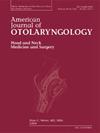耳硬化症椭圆窗区受累超高分辨率ct评分与听力学的关系
IF 1.7
4区 医学
Q2 OTORHINOLARYNGOLOGY
引用次数: 0
摘要
目的探讨耳硬化症患者椭圆窗区(OWR)受累的超高分辨率计算机断层扫描(U-HRCT)评分与听力的关系。方法对临床疑似耳硬化的患者行U-HRCT检查。分析纳入50例患者71耳,平均年龄38.0[34.0-49.8]岁。耳分为传导性听力损失组(A组,20耳)和混合性听力损失组(B组,51耳)。卵圆窗周围骨受累的CT评分(0,无;1, < 25%;2、25% - 50%;3、50% - 75%;4, > 75%)和镫骨踏板受累(0,无;1, < 50%;2例(> 50%)进行评估和汇总,得出OWR受累的CT评分。采用Mann-Whitney U检验比较A组与b组间腰骨损伤CT评分分布的差异。采用Spearman秩相关分析评价腰骨损伤CT评分与平均空气传导(AC)、骨传导(BC)、气骨间隙(ABG)的相关性。结果B组wr受累CT评分明显高于A组(p = 0.014)。OWR受累的CT评分与平均AC、BC、ABG阈值的相关系数为0.74 (p <;.001), 0.52 (p <;.001), 0.48 (p <;措施)。结论u - hrct能清晰显示耳硬化的OWR。u - hrct耳硬化的OWR累及评分可以反映听力损失的类型和程度。本文章由计算机程序翻译,如有差异,请以英文原文为准。
Relationship between ultra-high-resolution computed tomography score of oval window region involvement and audiometry in otosclerosis
Purpose
To assess the relationship between the ultra-high-resolution computed tomography (U-HRCT) score of oval window region (OWR) involvement and audiometry in otosclerosis.
Methods
This study enrolled patients with clinically suspected otosclerosis who underwent U-HRCT examination. The analysis included 71 ears from 50 patients (mean age, 38.0 [34.0–49.8] years). The ears were divided into the conductive hearing loss group (group A, 20 ears) and mixed hearing loss group (group B, 51 ears). The CT scores of bone involvement around the oval window (0, none; 1, <25 %; 2, 25 %–50 %; 3, 50 %–75 %; 4, >75 %) and stapes footplate involvement (0, none; 1, <50 %; 2, >50 %) were evaluated and summed to obtain the CT score of OWR involvement. The Mann–Whitney U test was used to compare the difference in the distribution of the CT score of OWR involvement between groups A and B. Spearman's rank correlation analysis was performed to evaluate the association between the CT score of OWR involvement and the mean air conduction (AC), bone conduction (BC) and air-bone gap (ABG).
Results
The CT score of OWR involvement in group B was significantly higher than that in group A (p = .014). The correlation coefficients between the CT score of OWR involvement and the mean AC, BC, and ABG threshold were 0.74 (p < .001), 0.52 (p < .001), and 0.48 (p < .001).
Conclusion
U-HRCT possesses the ability to clearly depict the OWR in otosclerosis. The U-HRCT-derived OWR involvement score of otosclerosis could reflect the type and degree of hearing loss.
求助全文
通过发布文献求助,成功后即可免费获取论文全文。
去求助
来源期刊

American Journal of Otolaryngology
医学-耳鼻喉科学
CiteScore
4.40
自引率
4.00%
发文量
378
审稿时长
41 days
期刊介绍:
Be fully informed about developments in otology, neurotology, audiology, rhinology, allergy, laryngology, speech science, bronchoesophagology, facial plastic surgery, and head and neck surgery. Featured sections include original contributions, grand rounds, current reviews, case reports and socioeconomics.
 求助内容:
求助内容: 应助结果提醒方式:
应助结果提醒方式:


